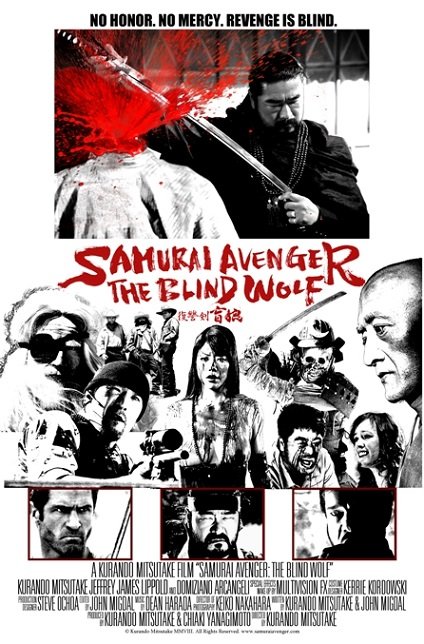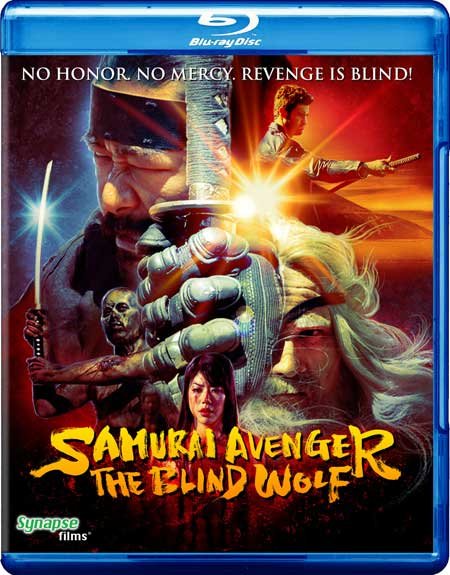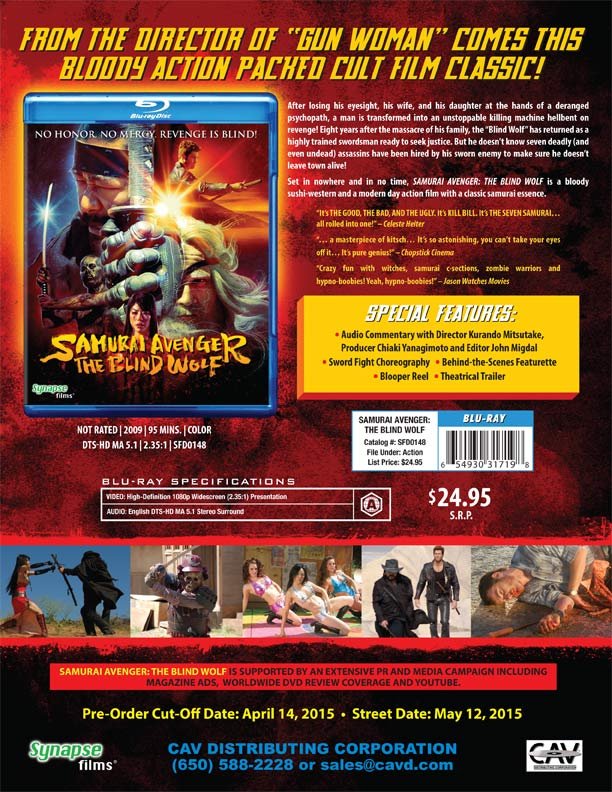SAMURAI AVENGER: THE BLIND WOLF: Showdown At The Faux Grindhouse Dojo
A recurring problem in the faux-grindhouse movies being made today is the disconnect between form and content. It's possible to get all the surface details right and still miss out on what truly makes the films you love special. Most of the people behind the flicks that inspired faux-grindhouse auteurs were trying to tell the best stories they could tell, giving it their heart and soul. Any modern grindhouse tribute that wants to transcend its references and tropes needs to be invested with that same passion for storytelling. If you can't do that, you run the risk of reducing what has inspired you to little more than a kitschy joke. Sadly, Samurai Avenger: The Blind Wolf is the kind of faux-grindhouse enterprise that frequently errs on the side on campiness. Presenting itself as a long-lost samurai/spaghetti-western/grindhouse opus, its titular figure (played by director/co-writer Kurando Mitsutake) is an archetypal man on a revenge mission. Years ago, his wife and daughter were brutally killed by Flesher (Domiziano Arcangeli).The Blind Wolf emerges from his training just in time for Flesher's release from prison. Of course, the villain is aware of the Blind Wolf and has paid off a variety of colorful assassins to kill him. The Blind Wolf forms an uneasy alliance with a mysterious Drifter (Jeffrey James Lippold) as he fights his way through the assassins' ranks - but revenge is never easy and the Blind Wolf has many hidden dangers to face on the road ahead.Mitsutake is obviously a devoted student of the films he is referencing - the end credits namecheck Tomisaburo Wakayama, Shintaro Katsu and Bruno Corbucci - and Samurai Avenger: The Blind Wolf reflects his admiration for those sources. To his credit, he gets a lot of the stylistic tics of those film just right in a way many faux-grindhouse films are too lazy to try for: the scope photography looks great for a micro-budget indie and he choreographs the fight scenes with skill. It also boasts an excellent rock score by Dean Harada that evokes Morricone in an effective way.
Sadly, Samurai Avenger: The Blind Wolf is the kind of faux-grindhouse enterprise that frequently errs on the side on campiness. Presenting itself as a long-lost samurai/spaghetti-western/grindhouse opus, its titular figure (played by director/co-writer Kurando Mitsutake) is an archetypal man on a revenge mission. Years ago, his wife and daughter were brutally killed by Flesher (Domiziano Arcangeli).The Blind Wolf emerges from his training just in time for Flesher's release from prison. Of course, the villain is aware of the Blind Wolf and has paid off a variety of colorful assassins to kill him. The Blind Wolf forms an uneasy alliance with a mysterious Drifter (Jeffrey James Lippold) as he fights his way through the assassins' ranks - but revenge is never easy and the Blind Wolf has many hidden dangers to face on the road ahead.Mitsutake is obviously a devoted student of the films he is referencing - the end credits namecheck Tomisaburo Wakayama, Shintaro Katsu and Bruno Corbucci - and Samurai Avenger: The Blind Wolf reflects his admiration for those sources. To his credit, he gets a lot of the stylistic tics of those film just right in a way many faux-grindhouse films are too lazy to try for: the scope photography looks great for a micro-budget indie and he choreographs the fight scenes with skill. It also boasts an excellent rock score by Dean Harada that evokes Morricone in an effective way. Unfortunately, Samurai Avenger: The Blind Wolf tends to undercut its strengths with the same kind of Troma-inspired wackiness that plagued Hobo With A Shotgun. For example, there's a goofy title sequence with go-go girls, some zombies thrown in for no apparent reason and overdone, deliberately cartoonish splatter and cheap CGI. Most of the villains are encouraged to go way over the top, particularly the unbearably hammy Arcangeli. Worst of all, the flashback to the hero's family-loss tragedy has a disturbing sexual violence element that casts a shadow over the otherwise lighthearted style of the rest of the film.As a result, the tone of Samurai Avenger: The Blind Wolf is all over the map and story is often subjugated to the setpieces instead of both elements being allowed to work together. This is a shame because the third act shows Mitsutake also wants the viewer to be emotionally invested in his heroes, an aim that comes unraveled when the film crams in elements designed for cheap laughs or shocks. If he'd trusted his story enough to try playing it straight, Samurai Avenger: The Blind Wolf could have worn its genre-mashing weirdness like a badge of honor. Instead, Mitsutake tries too hard to be outrageous and the final film is both too contrived and too disjointed to satisfy the way its inspirations do.
Unfortunately, Samurai Avenger: The Blind Wolf tends to undercut its strengths with the same kind of Troma-inspired wackiness that plagued Hobo With A Shotgun. For example, there's a goofy title sequence with go-go girls, some zombies thrown in for no apparent reason and overdone, deliberately cartoonish splatter and cheap CGI. Most of the villains are encouraged to go way over the top, particularly the unbearably hammy Arcangeli. Worst of all, the flashback to the hero's family-loss tragedy has a disturbing sexual violence element that casts a shadow over the otherwise lighthearted style of the rest of the film.As a result, the tone of Samurai Avenger: The Blind Wolf is all over the map and story is often subjugated to the setpieces instead of both elements being allowed to work together. This is a shame because the third act shows Mitsutake also wants the viewer to be emotionally invested in his heroes, an aim that comes unraveled when the film crams in elements designed for cheap laughs or shocks. If he'd trusted his story enough to try playing it straight, Samurai Avenger: The Blind Wolf could have worn its genre-mashing weirdness like a badge of honor. Instead, Mitsutake tries too hard to be outrageous and the final film is both too contrived and too disjointed to satisfy the way its inspirations do. Blu-Ray Notes: This film has recently received a lovely, fully-loaded blu-ray release from Synapse Films. The transfer does well by the film's ' scope-format lensing, bringing in vivid colors and crisp details that belie its deliberately "print-damaged" appearance. It's accompanied by a 5.1 lossless stereo mix that makes good use of splattery sound effects and the rock score.This disc also has tons of special features. A commentary featuring Mitsutake, producer and editor/co-writer James Migdal goes deep into technical details, with lot of specifics on visual techniques, makeup effects and the many cinematic influences the film touches upon. There's also a 90-minute making-of documentary that includes interviews with all key cast and crew plus tons of behind-the-scenes footage. There's even a neat section on the musical score.Next up is a video short called "Sword Fight Choreography" that features action choreographer Peter Steeves demonstrating basic sword techniques and basic choreography for the fights. The cast studied it as a guide during the shoot so it's a particularly noteworthy inclusion. A couple of animated slideshows follow, one devoted to production stills and the other to character designs and storyboards drawn in a manga-esque style.The final bonus items are a storyboard/scene comparison for the opening sequence that shows just how closely the storyboards were followed, a ten-minute blooper reel and a trailer that exploits the film's wild imagery well. All in all, this disc is another fine example of Synapse giving a loving home video treatment to a lesser-known indie effort.
Blu-Ray Notes: This film has recently received a lovely, fully-loaded blu-ray release from Synapse Films. The transfer does well by the film's ' scope-format lensing, bringing in vivid colors and crisp details that belie its deliberately "print-damaged" appearance. It's accompanied by a 5.1 lossless stereo mix that makes good use of splattery sound effects and the rock score.This disc also has tons of special features. A commentary featuring Mitsutake, producer and editor/co-writer James Migdal goes deep into technical details, with lot of specifics on visual techniques, makeup effects and the many cinematic influences the film touches upon. There's also a 90-minute making-of documentary that includes interviews with all key cast and crew plus tons of behind-the-scenes footage. There's even a neat section on the musical score.Next up is a video short called "Sword Fight Choreography" that features action choreographer Peter Steeves demonstrating basic sword techniques and basic choreography for the fights. The cast studied it as a guide during the shoot so it's a particularly noteworthy inclusion. A couple of animated slideshows follow, one devoted to production stills and the other to character designs and storyboards drawn in a manga-esque style.The final bonus items are a storyboard/scene comparison for the opening sequence that shows just how closely the storyboards were followed, a ten-minute blooper reel and a trailer that exploits the film's wild imagery well. All in all, this disc is another fine example of Synapse giving a loving home video treatment to a lesser-known indie effort.


